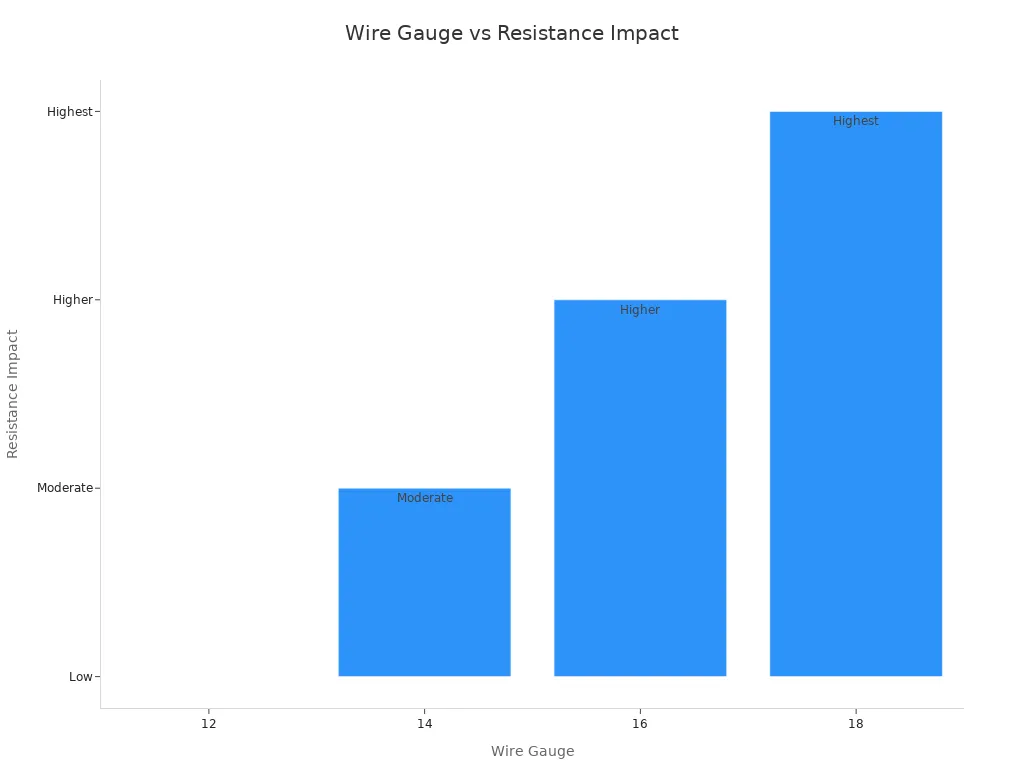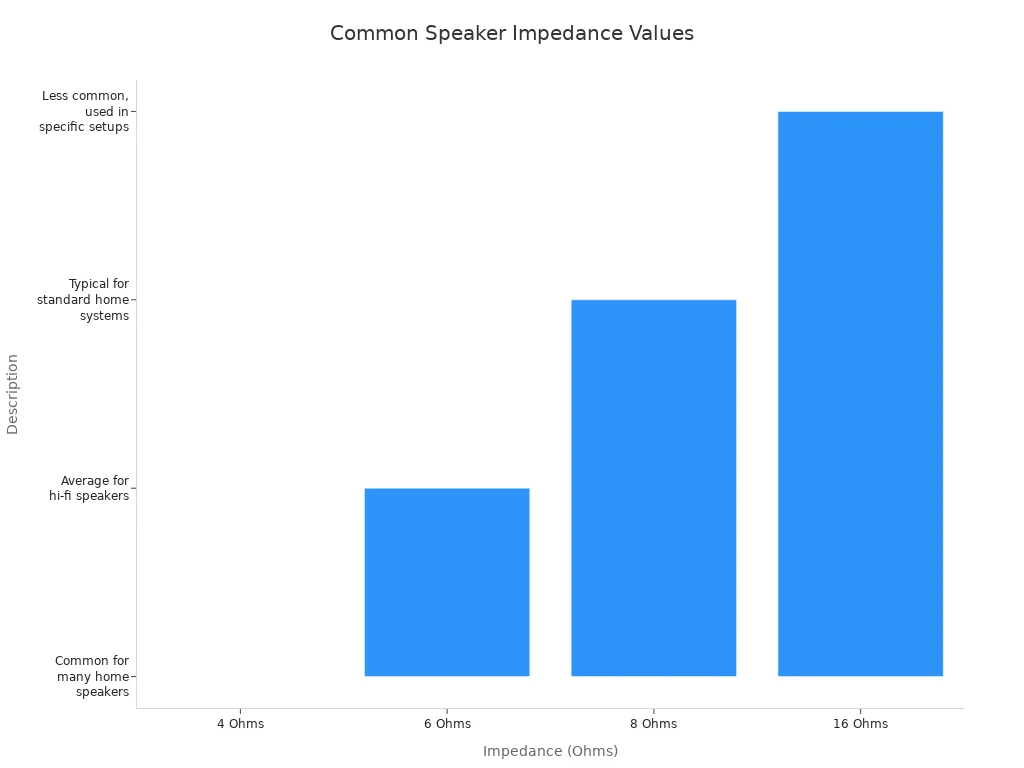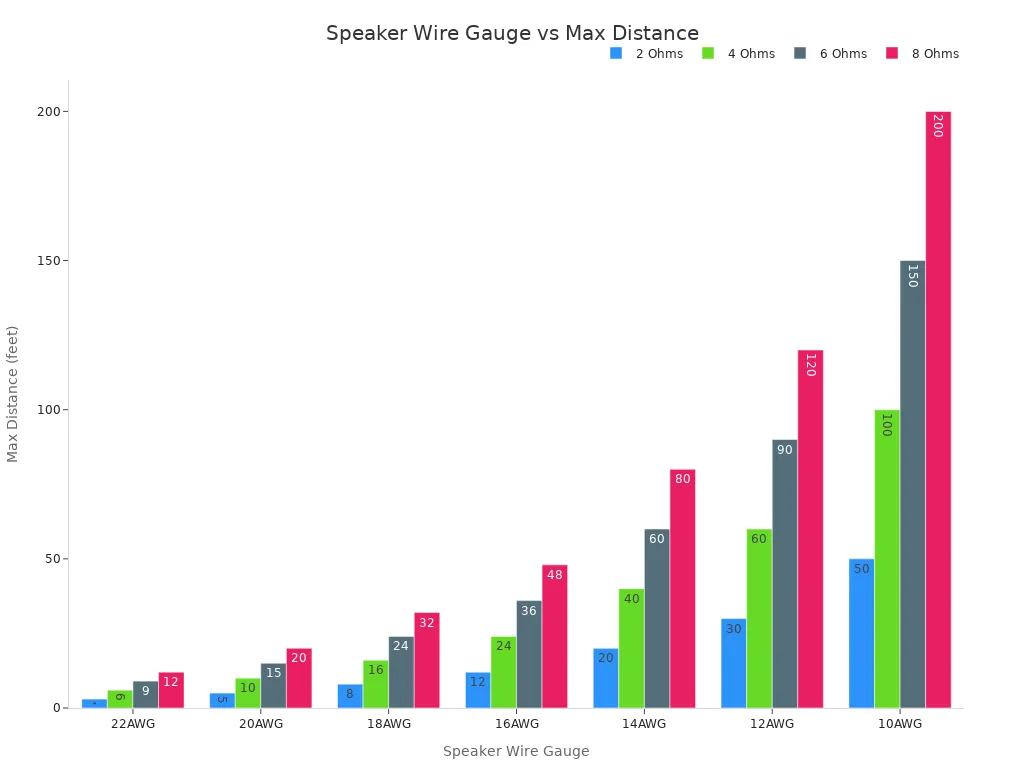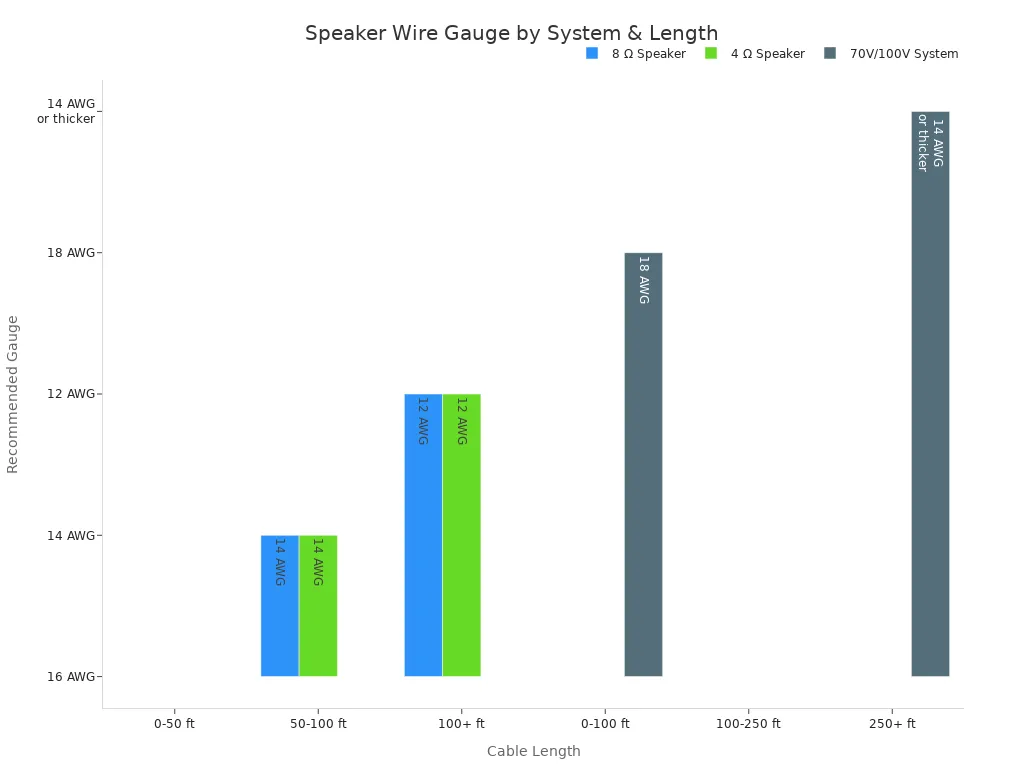Views: 0 Author: Site Editor Publish Time: 2025-10-10 Origin: Site








You want your speakers to sound great. For most setups, use 16-gauge wire for short distances. Use 14-gauge wire for longer distances. Use 12-gauge wire for strong power or pro systems. The wire thickness is called speaker wire gauge. Wire gauge changes resistance and sound quality. Lower resistance gives you clearer sound. Look at the table to see how resistance changes with wire gauge:
Wire Gauge | Thickness | Resistance Impact | Recommended Use |
|---|---|---|---|
12 | Thick | Low | Long distances or low-impedance speakers |
14 | Medium | Moderate | Moderate distances or low-impedance speakers |
16 | Thin | Higher | Short distances with 8-ohm speakers |
18 | Thinnest | Highest | Not recommended for audio applications |

FDB Audio makes great sound systems. Picking the right wire helps you hear every detail. This shows why speaker wire gauge matters.
Pick 16-gauge wire for short distances. This helps keep sound clear. If the wire is longer than 50 feet, use 12-gauge wire. This lowers resistance and makes sound better. Choose wire gauge by looking at speaker impedance. Speakers with lower impedance need thicker wire. Measure how far your amplifier is from your speakers before you buy wire. This helps you pick the right gauge. Do not use different wire gauges in one system. This keeps sound balanced and stops signal loss.
You may ask what speaker wire gauge means. It tells you how thick the wire is. This wire connects your speakers to an amplifier or receiver. The audio world uses the American Wire Gauge (AWG) system. AWG gives each wire a number. Bigger numbers mean the wire is thinner. Smaller numbers mean the wire is thicker. For example, 12 AWG is much thicker than 18 AWG. AWG checks the wire's cross-section. This affects how electricity moves through the wire.
Speaker wire gauge shows how thick the wire is.
It connects speakers to an amplifier or receiver.
AWG gives each wire a number.
Higher numbers mean thinner wires.
Lower numbers mean thicker wires.
AWG measures the cross-section, not just the diameter.
Most home and pro audio systems use common gauges. These are 12 AWG, 14 AWG, 16 AWG, and 18 AWG. Each size works best for certain setups and distances.
Wire Gauge | Recommended Use | Speaker Impedance | Length |
|---|---|---|---|
12 AWG | Good for strong power | 4-ohm speakers | Over 50 feet |
14 AWG | Works for most setups | 6-8 ohm speakers | Up to 50 feet |
16 AWG | Great for home audio | 8-ohm speakers | Under 30 feet |
18 AWG | Best for small speakers | Small speakers | Under 20 feet |
Speaker wire gauge is important for sound quality. Thicker wires have less resistance. This lets more electricity flow. Your speakers get the power they need. The sound stays clear. If the wire is too thin, resistance goes up. This makes the sound worse.
Thicker wires lower resistance and help current flow.
Less resistance means better sound, especially for long wires or strong power.
Bigger wires move power better and stop sound loss.
If you use wire that is too thin, resistance gets high. This can hurt your audio system. For example, thin wire for a loudspeaker can double resistance. It can cut the voltage in half. Power drops to one-fourth. You lose volume and sound quality.
Picking the right speaker wire gauge helps your system sound its best. You keep your equipment safe. You enjoy music and movies with clear sound.
Choosing the best gauge for speaker wire helps you get the most from your audio system. The right wire size depends on how far your speakers are from your amplifier and how much power you need. FDB Audio designs systems for many uses, so picking the correct wire gauge makes sure you hear every detail.
Short runs mean the distance between your amplifier and speakers is less than 50 feet. For most home setups, this is common. You want to use a wire that keeps resistance low but does not need to be extra thick.
For 8-ohm speakers, 16-gauge wire works well for short runs.
If you use lower impedance speakers or want extra safety, you can choose 14-gauge wire.
For everyday listening at low or medium power, 18-gauge wire can work, but it is not the most common speaker wire gauge for quality sound.
Speaker Impedance | Recommended Gauge |
|---|---|
8 Ohm | 16 AWG |
Lower Impedance | 12-14 AWG |
Everyday Listening | 18 AWG |
You get clear sound and strong performance when you match the wire to your setup. FDB Audio's home and portable systems benefit from the right wire, letting you enjoy music without signal loss.
Long runs happen when your speakers are more than 50 feet from your amplifier. Longer wires increase resistance, which can lower sound quality. You need a thicker wire to keep the signal strong.
Use 12-gauge wire for long runs or if you have 4-ohm speakers.
Thicker wire means lower resistance, so your speakers get more power.
If you use 14-gauge wire for long runs, you may lose some sound quality, especially with high-power systems.
Tip: Doubling the wire length doubles the resistance. Always measure the distance before you buy wire.
High-power setups need more current. These setups include professional audio systems, live events, or powerful home theaters. You want a wire that can handle the load safely.
Choose a lower speaker wire gauge, like 12-gauge wire, for high-power systems.
Thicker wire improves sound quality by delivering steady power.
It also increases efficiency and keeps your equipment safe by reducing the risk of overheating.
When you use FDB Audio's performance systems or amplifiers, the right wire gauge helps you get the best results. You protect your gear and enjoy crisp, powerful sound.
Note: A higher speaker wire gauge means a thinner wire. For high-power setups, always use a lower speaker wire gauge for safety and performance.
Selecting the best gauge for speaker wire is simple when you know your needs. Short runs use 16-gauge wire. Long runs or high-power setups need 14-gauge wire or thicker. FDB Audio's advanced systems work best when you match the wire to the job.
When you select the right speaker wire, you need to look at several important details. These factors to consider when choosing speaker wire help you get the best sound from your system. The main things to check are impedance, distance, and power.
Impedance measures how much a speaker resists electrical current. You see this value in ohms. Most home and professional speakers have ratings of 4, 6, or 8 ohms. Some special setups use 16 ohms. Here is a quick guide:
Impedance (Ohms) | Description |
|---|---|
4 | Common for many home speakers |
6 | Average for hi-fi speakers |
8 | Typical for standard home systems |
16 | Less common, used in specific setups |
Most hi-fi speakers use 6 ohms.
Home stereo speakers often have 4, 6, or 8 ohms.
If your speakers have 4 ohms or fewer, you should use 14- or 12-gauge wire. These thicker wires handle more power and keep resistance low. For 6-ohm speakers, 16-gauge wire works well. For 8-ohm speakers, you can use 16- or 18-gauge wire for short runs, but use 12 or 14 AWG for longer distances. Thicker wire means less resistance, so your sound stays clear.

Distance between your amplifier and speakers changes how much resistance the wire adds. Longer wires increase resistance, which can lower sound quality. You want to keep wire runs as short as possible. If you need a long run, pick a lower speaker wire gauge. Thicker wire helps keep the signal strong over longer distances.
Tip: Always measure the distance before you buy wire. Longer runs need thicker wire to prevent signal loss.
Power from your amplifier also affects your choice. High-power systems push more current through the wire. Thicker wire (lower gauge) can carry more power without overheating. If you use a wire that is too thin, it can overheat and damage your equipment. Thicker wire also reduces signal loss, which is important for high-fidelity sound.
Higher power speakers need thicker wire.
Lower gauge wire carries more power and keeps your system safe.
Using the right wire gauge helps your audio system last longer.
Choosing the right speaker wire gauge depends on these three main factors. When you match the wire to your system's needs, you get better sound and protect your equipment.
You want your speakers to sound good. The thickness of the speaker wire matters a lot. Thicker wire has less resistance. This means more signal gets to your speakers. If you use thin wire, resistance goes up. Your speakers might not play as loud. The music might sound different.
Wire resistance can lower the power your speakers get.
High resistance can change the damping factor. This can change how your speakers sound and add unwanted noise.
The damping factor is a number. It compares your speaker's impedance to all the resistance in the circuit, including the wire. If the wire's resistance goes up, your amplifier cannot control the speaker as well. This can change the sound, especially at some frequencies.
Here is a table that shows resistance for different wire gauges per 100 feet:
Wire Gauge | Ohms per 100 ft. |
|---|---|
16 | 0.40160 |
14 | 0.25250 |
12 | 0.15880 |
Picking the right speaker wire gauge helps you get better sound. It lowers resistance and keeps your music clear.
You may wonder if you can hear the difference between wire sizes. In most homes with short wires, you might not notice much change. But if the wire is very thin or very long, you can hear less volume or lose details.
In a study from 1983, people could not tell the difference between 16-gauge lamp cord and fancy cable. But they did notice a change with very thin 24-gauge wire because of higher resistance.
The wire's impedance can change sound quality, especially if it is more than 5% of the speaker's lowest impedance.
Different wire gauges work with speakers in different ways. This can sometimes make the sound change.
Audio engineers say thin wire may not always hurt sound, but it can waste power and lower volume. For the best sound, always use the right wire size for your system. This gives you better audio and helps your equipment work well.
You need to measure the distance from your amplifier to your speakers before you buy wire. Use a tape measure to follow the path the wire will take, not just a straight line. Add a little extra length for corners or bends. This helps you avoid running out of wire during installation. Write down the total length so you can choose the right speaker wire gauge for your setup.
Tip: Always round up your measurement. It is better to have a little extra wire than not enough.
When you shop for wire, you should check the label to make sure you get the correct size and type. Look for these details:
The wire gauge number, such as 12 AWG or 16 AWG, printed on the packaging.
The UL Mark, which shows the wire has passed safety tests.
The Listing Mark, which includes the UL Solutions symbol, the word 'LISTED', a serial number, and the product or category name.
These details help you pick the right wire for your speakers and keep your system safe.
Many people make simple mistakes when choosing or installing speaker wire. Avoid these common errors:
Do not use wire that is too thin for long runs or high-power systems.
Do not mix different wire types in the same setup.
Do not use old or damaged wire, as it can lower sound quality.
Do not forget to match the wire quality to your audio system.
Choosing a high-quality audio cable makes a big difference for FDB Audio systems. The table below shows why copper wire is better than copper-clad aluminum (CCA) wire:
Attribute | Copper Speaker Wire | Copper-Clad Aluminum (CCA) Wire |
|---|---|---|
Electrical Conductivity | Superior conductivity, lower resistance | Lower conductivity, higher resistance |
Durability | More durable, resists oxidation, lasts longer | More prone to oxidation, shorter lifespan |
Cost | More expensive | Cheaper |
You get better sound and longer life when you use copper wire. Always choose the best wire for your speakers to enjoy clear music and protect your equipment.
You want to pick the right wire for your speakers without guessing. A quick reference table gives you the answers fast. You can see the best wire size for your speaker's impedance and the distance from your amplifier. This helps you avoid mistakes and keeps your sound clear.
Tip: Always choose a thicker wire if you are close to the maximum distance for your setup.
Here is a table you can use to find the right wire size for your speakers:
Speaker Wire Gauge | 2 Ohms Speakers | 4 Ohms Speakers | 6 Ohms Speakers | 8 Ohms Speakers |
|---|---|---|---|---|
22AWG | 3 feet | 6 feet | 9 feet | 12 feet |
20AWG | 5 feet | 10 feet | 15 feet | 20 feet |
18AWG | 8 feet | 16 feet | 24 feet | 32 feet |
16AWG | 12 feet | 24 feet | 36 feet | 48 feet |
14AWG | 20 feet | 40 feet | 60 feet | 80 feet |
12AWG | 30 feet | 60 feet | 90 feet | 120 feet |
10AWG | 50 feet | 100 feet | 150 feet | 200 feet |
This table shows the longest wire length you should use for each speaker wire gauge and speaker impedance. If your setup needs more distance, move to a thicker wire.
You can also use this chart to see the same information at a glance:

A quick reference table saves you time. You do not need to do math or look up numbers. You just check the table and pick the right wire. This keeps your audio system safe and helps you get the best sound.
You can trust this guide to help you choose the right speaker wire gauge for your FDB Audio system or any other setup.
You get the best sound when you pick the right speaker wire gauge. Look at the table below to find the best match for your system. Check your system type, speaker impedance, and cable length. Then use the recommended gauge. This stops signal loss and keeps your FDB Audio system working well.
System Type | Speaker Impedance | Cable Length | Recommended Gauge | Notes |
|---|---|---|---|---|
Low-Impedance Audio | 8 Ω | 0-50 ft | 16 AWG | Standard for most home & studio setups |
8 Ω | 50-100 ft | 14 AWG | Use thicker wire to minimize resistance | |
8 Ω | 100+ ft | 12 AWG | Long runs benefit from low resistance | |
Low-Impedance Audio | 4 Ω | 0-50 ft | 16 AWG | 4 Ω speakers draw more current |
4 Ω | 50-100 ft | 14 AWG | Higher current = more voltage drop risk | |
4 Ω | 100+ ft | 12 AWG | Consider relocating amp or using 70V | |
70V/100V Systems | High-impedance | 0-100 ft | 18 AWG | Thin cable is fine due to low current |
100-250 ft | 16 AWG | Size up for high wattage | ||
250+ ft | 14 AWG or thicker | Consider total speaker load |

Use the quick reference table and tips to make setup simple. The right wire gives you clear and strong sound every time.
If you use a wire that is too thin, you may lose sound quality. Thicker wire helps keep your music clear. Always match the wire gauge to your speaker's distance and power needs.
You should avoid mixing wire gauges. Using the same gauge for all speakers keeps the sound balanced. Different gauges can cause uneven volume or signal loss.
Yes, wire material matters. Copper wire gives you the best sound and lasts longer. Copper-clad aluminum (CCA) wire has higher resistance and may lower sound quality.
Measure the distance from your amplifier to your speakers. Check your speaker's impedance. Use the quick reference table to find the best wire gauge for your needs.